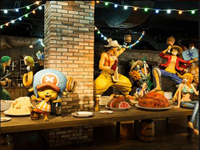Nagasaki Atomic Bomb Museum

Stories of Destruction
August 9th, 1945, 11:02 am. Three days after the atomic bomb was dropped on Hiroshima, another atomic bomb was dropped on the Urakami district in Nagasaki city, taking the lives of about 150,000 people. This museum tells the story of the bomb's damage in a realistic way through various exhibits.

(Source: flickr/ othree)
Real-life Size Replica of the Atomic Bomb Dropped on Nagasaki
Inside the Atomic Bomb Museum, there is a real-life size replica of the Nagasaki Atomic Bomb "Fat Man" and can be observed from up close. Anyone would be shocked by the gap between the small size of the only 3-meter long and 1.5-meter wide bomb, and the scope of the damage it caused.

(Source: flickr/ Hajime NAKANO)
Cathedral that was Blown Away
Urakami district has had a history of Christianity since the late 16th century. Urakami Cathedral was the largest cathedral in all of east Asia, but was however blown away by the atomic bomb with only a sidewall remaining. A replica of this sidewall of Urakami Cathedral is exhibited here.

(Source: ながさき旅ネット)
Nagasaki Heiwa Koen (Peace Park)
Nagasaki Peace Park was built with an oath to never repeat such a tragic war and a wish for world peace. The park is open for anyone to enter and is located in Matsuyama-machi, the center of where the bomb was dropped on August 9th, 1945.

Ground Zero Park
This ground zero park is located across from the Peace Park. There is a pillar standing at the hypocenter of the Nagasaki atomic bomb. This pillar represents the center point, on which the bomb was dropped and its surrounding is made into a circle, indicating that the bomb exploded at about 500 meters above ground. The memorial stone in front of the pillar contains a macrofilm with the names of victims who lost their lives to the atomic bomb.

Stories of Destruction
August 9th, 1945, 11:02 am. Three days after the atomic bomb was dropped on Hiroshima, another atomic bomb was dropped on the Urakami district in Nagasaki city, taking the lives of about 150,000 people. This museum tells the story of the bomb's damage in a realistic way through various exhibits.

(Source: flickr/ othree)
Real-life Size Replica of the Atomic Bomb Dropped on Nagasaki
Inside the Atomic Bomb Museum, there is a real-life size replica of the Nagasaki Atomic Bomb "Fat Man" and can be observed from up close. Anyone would be shocked by the gap between the small size of the only 3-meter long and 1.5-meter wide bomb, and the scope of the damage it caused.

(Source: flickr/ Hajime NAKANO)
Cathedral that was Blown Away
Urakami district has had a history of Christianity since the late 16th century. Urakami Cathedral was the largest cathedral in all of east Asia, but was however blown away by the atomic bomb with only a sidewall remaining. A replica of this sidewall of Urakami Cathedral is exhibited here.

(Source: ながさき旅ネット)
Nagasaki Heiwa Koen (Peace Park)
Nagasaki Peace Park was built with an oath to never repeat such a tragic war and a wish for world peace. The park is open for anyone to enter and is located in Matsuyama-machi, the center of where the bomb was dropped on August 9th, 1945.

Ground Zero Park
This ground zero park is located across from the Peace Park. There is a pillar standing at the hypocenter of the Nagasaki atomic bomb. This pillar represents the center point, on which the bomb was dropped and its surrounding is made into a circle, indicating that the bomb exploded at about 500 meters above ground. The memorial stone in front of the pillar contains a macrofilm with the names of victims who lost their lives to the atomic bomb.







